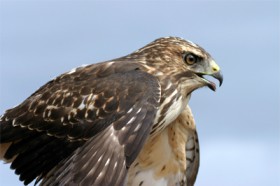Broad-winged Hawk

Peak Migration: 10 Sep - 25 Sep
Record Daily High: 101,698 on Sept 15, 2003
Record Seasonal High: 160,703 in 2003
Other name: Broad-winged buzzard
Hunting habits: Usually perches on a snag or branch in the woods, and drops down to catch frogs, toads, snakes, lizards, red squirrels, chipmunks, mice, shrews, rabbits, small birds, large caterpillars, grasshoppers, crickets, beetles, dragonflies, ants, spiders, crayfishes, and worms.
Migrating habits: Although these are the most abundant migrants over the ridge in September each year, relatively few broad-wings are caught by the banders because they migrate at high altitudes and seldom stop to hunt during the days of their travels. Because of their dependence on cold-blooded terrestrial prey species, they migrate all the way to Central and even South America. In order to conserve energy on their long journey, they float upward on vertical air currents as high as they can go, and then shoot forward. When one broad-wing discovers a thermal or updraft, others quickly join it, all swirling upward in a “kettle”. Their migration is one of the most exciting spectacles of the natural world.
Nesting habits: Nests usually near water in the woods. Both sexes build the nest, and keep it decorated with sprigs of pine or oak leaves. Both sexes incubate the 2-3 eggs. It takes them 3 to 4 weeks to hatch, and the young leave the nest when about 41 days old.
Length: 13-19 inches
Wingspan: 32-39 inches
Weight: Females average 17 ounces, males 14-15 ounces. In the world of raptors, there is no such thing as “macho.” Females are bigger, stronger, and usually more aggressive than males, so the word might as well be “macha.”
Life expectancy: One banded in Winnipeg was shot when 7 1/2 years old. Another banded bird survived 18 years, 4 months.
Image Credits: Michael Furtman

